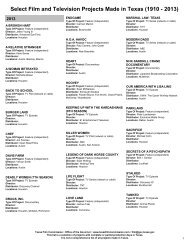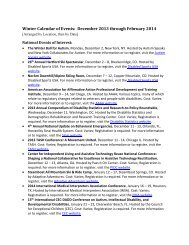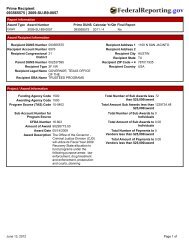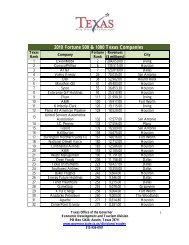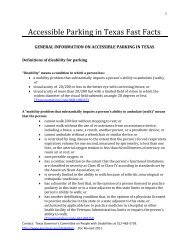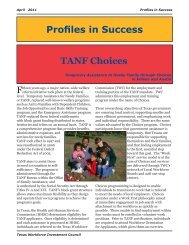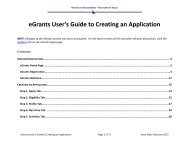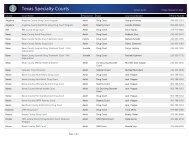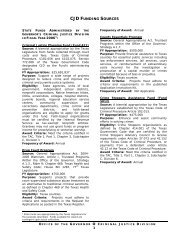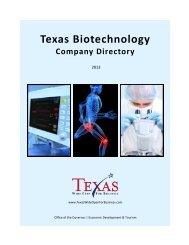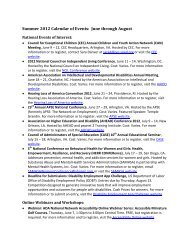People with Disabilities: A Texas Profile
People with Disabilities: A Texas Profile
People with Disabilities: A Texas Profile
You also want an ePaper? Increase the reach of your titles
YUMPU automatically turns print PDFs into web optimized ePapers that Google loves.
Table 8: Percentages of Texans <strong>with</strong> and <strong>with</strong>out <strong>Disabilities</strong> by Education Level, 2011<br />
Total Number of<br />
Individuals Age 25<br />
and Over in Each<br />
With a Disability Without a Disability<br />
Education Level<br />
Education Category Number Percent Number Percent<br />
Less than high school graduate 2,923,060 743,077 25.4% 2,179,983 74.6%<br />
High school graduate (includes equivalency) 3,988,652 761,836 19.1% 3,226,816 80.9%<br />
Some college or associate degree 4,591,887 657,524 14.3% 3,934,363 85.7%<br />
Bachelor degree or higher<br />
Noninstitutionalized population 25 years of<br />
4,239,441 339,374 8.0% 3,900,067 92.0%<br />
age and over 15,743,040 2,501,811 15.9% 13,241,229 84.1%<br />
Table notes: 2011 ACS microdata. Percentages represent the portion of the 25‐years‐old and older population<br />
<strong>with</strong> and <strong>with</strong>out disabilities at each education level.<br />
Table 9 illustrates the specific types of disabilities reported by Texans in 2011. The reported disability<br />
categories are not mutually exclusive and the same individual could report multiple disabilities.<br />
Approximately 1.6 million individuals, 53.6 percent of the population of individuals <strong>with</strong> disabilities,<br />
reported having an ambulatory difficulty. Approximately 37 percent of the population of individuals<br />
<strong>with</strong> disabilities reported cognitive difficulties, and 34.6 percent reported independent living difficulties.<br />
Hearing, self‐care, and vision difficulties were the fourth, fifth, and sixth most frequently reported.<br />
Table 9: Number of Individuals in <strong>Texas</strong> Reporting Each Type of Disability, 2011<br />
Disability Number Percent<br />
Ambulatory difficulty 1,567,087 53.6%<br />
Cognitive difficulty 1,090,515 37.3%<br />
Independent living difficulty 1,010,838 34.6%<br />
Hearing difficulty 842,803 28.8%<br />
Self‐care difficulty 624,602 21.4%<br />
Vision difficulty 615,836 21.1%<br />
Total <strong>with</strong> a disability 2,922,021<br />
Table notes: 2011 ACS microdata. Reported disability categories are not mutually exclusive and one individual<br />
could report having several disabilities. Percentages represent the portion of the population of individuals <strong>with</strong><br />
disabilities reporting each difficulty.<br />
The specific types of reported disabilities are presented in Table 10 by age categories. As previously<br />
noted, not all disability questions were asked of each age category. The increased prevalence of<br />
disabilities can again be observed for individuals in the older age categories. Less than one percent of<br />
the population under 5 years old is reported as having a disability. The most frequently reported<br />
disability of the population between the ages of five and 15 was cognitive difficulty, followed by self‐<br />
care and vision difficulties. For individuals between the ages of 16 and 24, cognitive difficulties were<br />
also the most frequently reported, followed by independent living, vision, and ambulatory difficulties.<br />
For all age categories over the age of 25, the most frequently reported difficulty was ambulatory. For<br />
<strong>Texas</strong> Workforce Investment Council 19



